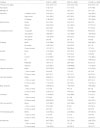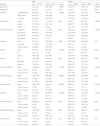1. Dann AB, Hontela A. Triclosan: environmental exposure, toxicity and mechanisms of action. J Appl Toxicol. 2011; 31(4):285–311. DOI:
10.1002/jat.1660. PMID:
21462230.

2. Calafat AM, Ye X, Wong LY, Reidy JA, Needham LL. Urinary concentrations of triclosan in the U.S. population: 2003-2004. Environ Health Perspect. 2008; 116(3):303–307. DOI:
10.1289/ehp.10768. PMID:
18335095.

3. Cullinan MP, Palmer JE, Carle AD, West MJ, Westerman B, Seymour GJ. The influence of a triclosan toothpaste on adverse events in patients with cardiovascular disease over 5-years. Sci Total Environ. 2015; 508:546–552. DOI:
10.1016/j.scitotenv.2014.11.052. PMID:
25442641.

4. Rodricks JV, Swenberg JA, Borzelleca JF, Maronpot RR, Shipp AM. Triclosan: a critical review of the experimental data and development of margins of safety for consumer products. Crit Rev Toxicol. 2010; 40(5):422–484. DOI:
10.3109/10408441003667514. PMID:
20377306.

5. Sandborgh-Englund G, Adolfsson-Erici M, Odham G, Ekstrand J. Pharmacokinetics of triclosan following oral ingestion in humans. J Toxicol Environ Health A. 2006; 69(20):1861–1873. DOI:
10.1080/15287390600631706. PMID:
16952905.

6. Den Hond E, Paulussen M, Geens T, Bruckers L, Baeyens W, David F, et al. Biomarkers of human exposure to personal care products: results from the Flemish Environment and Health Study (FLEHS 2007-2011). Sci Total Environ. 2013; 463-464:102–110. DOI:
10.1016/j.scitotenv.2013.05.087. PMID:
23792252.

7. Allmyr M, Harden F, Toms LM, Mueller JF, McLachlan MS, Adolfsson-Erici M, et al. The influence of age and gender on triclosan concentrations in Australian human blood serum. Sci Total Environ. 2008; 393(1):162–167. DOI:
10.1016/j.scitotenv.2007.12.006. PMID:
18207219.

8. Allmyr M, Adolfsson-Erici M, McLachlan MS, Sandborgh-Englund G. Triclosan in plasma and milk from Swedish nursing mothers and their exposure via personal care products. Sci Total Environ. 2006; 372(1):87–93. DOI:
10.1016/j.scitotenv.2006.08.007. PMID:
17007908.

9. Crofton KM, Paul KB, Devito MJ, Hedge JM. Short-term in vivo exposure to the water contaminant triclosan: evidence for disruption of thyroxine. Environ Toxicol Pharmacol. 2007; 24(2):194–197. DOI:
10.1016/j.etap.2007.04.008. PMID:
21783810.

10. Gee RH, Charles A, Taylor N, Darbre PD. Oestrogenic and androgenic activity of triclosan in breast cancer cells. J Appl Toxicol. 2008; 28(1):78–91. DOI:
10.1002/jat.1316. PMID:
17992702.

11. Henry ND, Fair PA. Comparison of in vitro cytotoxicity, estrogenicity and anti-estrogenicity of triclosan, perfluorooctane sulfonate and perfluorooctanoic acid. J Appl Toxicol. 2013; 33(4):265–272. DOI:
10.1002/jat.1736. PMID:
21935973.
12. Helbing CC, van Aggelen G, Veldhoen N. Triclosan affects thyroid hormone-dependent metamorphosis in anurans. Toxicol Sci. 2011; 119(2):417–418. DOI:
10.1093/toxsci/kfq343. PMID:
21071727.

13. Durbize E, Vigan M, Puzenat E, Girardin P, Adessi B, Desprez PH, et al. Spectrum of cross-photosensitization in 18 consecutive patients with contact photoallergy to ketoprofen: associated photoallergies to non-benzophenone-containing molecules. Contact Dermatitis. 2003; 48(3):144–149. DOI:
10.1034/j.1600-0536.2003.00066.x. PMID:
12755728.

15. Yoo J, Choi W, Jeon H, Joo Y, Lee C. Survey overview. Guidelines for using raw materials for Korean National Environmental Health Survey - the second stage ('12-'14). 2017. Incheon: Korean national institute of environmental research;p. 1–5.
16. Yoo J, Choi W, Jeon H, Joo Y, Lee C. Sample design. Guidelines for using raw materials for Korean National Environmental Health Survey - the second stage (‘12∼‘14). 2017. Incheon: Korean national institute of environmental research;p. 6–15.
17. Yoo J, Choi W, Jeon H, Joo Y, Lee C. Survey Items. Guidelines for using raw materials for Korean National Environmental Health Survey - the second stage (‘12∼‘14). 2017. Incheon: Korean national institute of environmental research;p. 28–29.
18. Yoo J, Choi W, Jeon H, Joo Y, Lee C. Analysis manual of environmental noxious materials. Guidelines for using raw materials for Korean National Environmental Health Survey - the second stage ('12-'14). 2017. Incheon: Korean national institute of environmental research;p. 54–67.
19. Arbuckle TE, Marro L, Davis K, Fisher M, Ayotte P, Belanger P, et al. Exposure to free and conjugated forms of bisphenol a and triclosan among pregnant women in the MIREC cohort. Environ Health Perspect. 2015; 123(4):277–284. DOI:
10.1289/ehp.1408187. PMID:
25494523.

20. Kim K, Park H, Yang W, Lee JH. Urinary concentrations of bisphenol a and triclosan and associations with demographic factors in the Korean population. Environ Res. 2011; 111(8):1280–1285. DOI:
10.1016/j.envres.2011.09.003. PMID:
21925656.

21. Boas M, Feldt-Rasmussen U, Main KM. Thyroid effects of endocrine disrupting chemicals. Mol Cell Endocrinol. 2012; 355(2):240–248. DOI:
10.1016/j.mce.2011.09.005. PMID:
21939731.

22. Krassas GE, Poppe K, Glinoer D. Thyroid function and human reproductive health. Endocr Rev. 2010; 31(5):702–755. DOI:
10.1210/er.2009-0041. PMID:
20573783.

23. Zoeller TR, Dowling AL, Herzig CT, Iannacone EA, Gauger KJ, Bansal R. Thyroid hormone, brain development, and the environment. Environ Health Perspect. 2002; 110(Suppl 3):355–361. DOI:
10.1289/ehp.02110s3355.

24. Cosmetics Research Team. Risk assessment of cosmetics. 2017. Cheongju-si: The National Institute of Food and Drug Safety Evaluation, Ministry of Food and Drug Safety;p. 151–172.
25. Cosmetic Ingredient Review Expert P. Final safety assessment of triclosan. Washington, DC: The cosmetic ingredient review; 2010. p.33–7.
27. Goldman LR. Children-unique and vulnerable. Environmental risks facing children and recommendations for response. Environ Health Perspect. 1995; 103(Suppl 6):13–18. DOI:
10.1289/ehp.95103s613.







